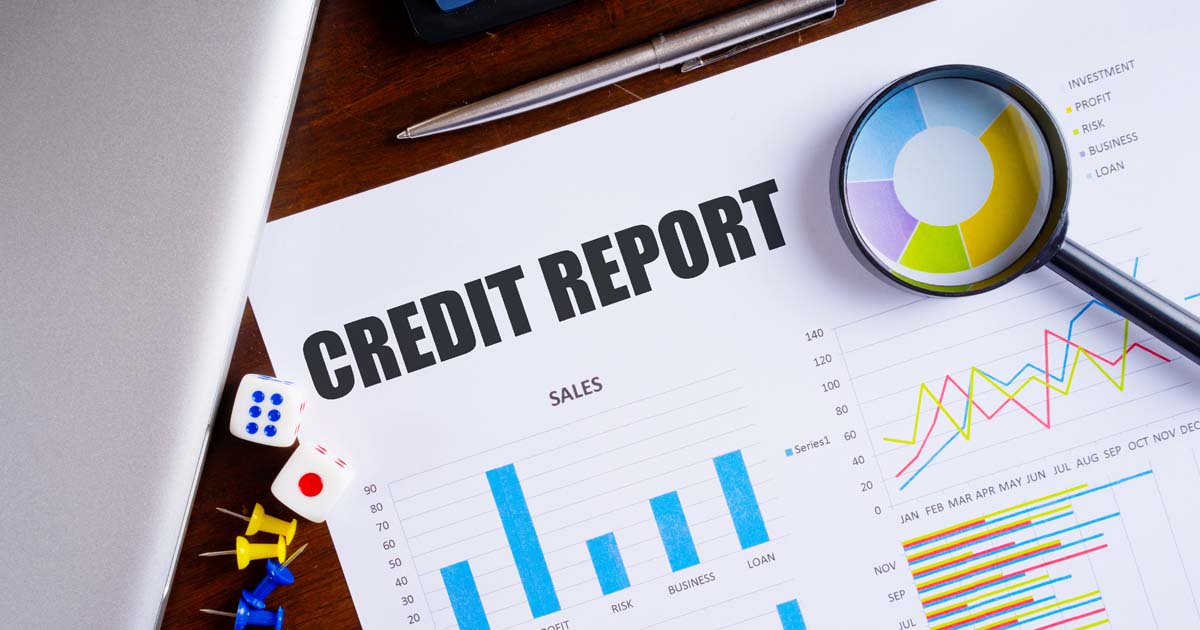For most B2B businesses, extending credit is a standard part of conducting business. That’s why extending credit to customers who are both able and willing to pay you on time is essential to reduce your credit risk and protect your business’ cash flow.
To evaluate the creditworthiness of a business, you can perform a credit check and check their company credit report. A credit report contains all the information you need to properly evaluate the financial position of a potential or existing customer’s business. The credit report will also help you to decide if you should take on a business as a customer and how likely you are to experience delays when following up on late payments.
To properly utilize your credit report, you need to learn how to read them. You also need to understand what each part of the credit report means and what it indicates about your customer or potential customer.
This article will show you how to perform a company credit check, set credit limits, and how to understand business credit scores. Here is everything you need to know about reading a company credit report and what you should look out for.
Company information
A company credit report contains information on the financial and business situation of your potential customer. Before you enter any contracts with a business or sign any financial agreements, it is important to verify the authenticity of the businesses you intent to extend credit to. This section of the credit report helps you validate that a business is who they say they are. Furthermore, it helps you to discover if the business has any association with another company with a poor credit history.
Within the report, you can view and verify all the key information about provided by your potential customer. This includes the business address, names of director/founders/operators, and contact information. In addition, it will contain the length of business operation, and matched data which includes things like previous names (if any) and alternate addresses.
Performing this initial check that the company firstly exists, but also matches up with what your prospective customer has shared with you will protect your business from potentially fraudulent customers.
Other information contained in this section includes a list of subsidiary companies (if any), operations abroad, and information about past company directors. The information about past directors would help you trace and identify previous filings for bankruptcy or other similar acts that tarnish a company’s credit rating.
For more context, it contains information on the incorporation status, business type, and the industry it operates. Number of employees, sales figures, and key individuals are also available in this section. The company information section gives you a glimpse at the company you are engaging with and all the relevant information you need to verify their authenticity.
If you are dealing with an existing late-paying customer and are having trouble verifying the authenticity of their company information and accessing contact details for the payment you are owed, consider utilizing debt recovery from a reputable provider. A debt recovery agency can help trace the details of your debtor and help you recover payments due.
Company credit limit
Want to determine how much credit you should offer a business? The credit limit section of the report provides you with a recommended credit limit for your potential customer. This section of the credit report usually recommends a maximum credit limit that you should set for your customer. This limit is calculated based on the company’s financial performance and its total liabilities.
The provided credit limit gives you an appropriate benchmark to gauge the safe levels of credit the business would be able to pay back comfortably. It would also prevent you from overstretching their business's credit capacity. It is important to always offer companies credit below the recommended credit limit to be on the safe side.
Company credit score
At a glance, the credit score on a company credit report provides a summary of the business's credit and financial history. The credit score is rated out of 100, with 100 being “your ideal” debtor. The closer the credit rating is to 100 the better their credit standing and ability to repay the credit extended. The score is displayed as a graph using a red, amber, and green color coding chart. Green means the company is in a good range, amber is average, and red is a poor credit score.
The credit score/rating section goes on to provide additional details that help you see a clearer picture. These include:
- It contains the “limiting factors” which have reduced the company’s credit rating. These details are part of the company's credit history and may include details of CCJs and writs against the business.
- The “risk summary” is a short paragraph that runs down the risk of non-payment. This is a short brief on the perceived risks the company has which hinders its ability to pay.
- The “risk comparison” examines the company’s credit score next to the risks of defaulting in its industry. It allows you to see any patterns or similarities between the credit you want to offer and defaults across the industry.
These are some of the additional details you would see in the credit score section of the company credit report. With a quick scan, you would be able to better assess and manage your business’ credit risk with this potential customer.
Note that it is possible for a business to not have a credit score assigned. This happens in cases where the company has had issues with bankruptcy or there is not sufficient information to give an accurate report. These are never good signs and you are advised to ask the company to provide more details or update their credit report.
Company payment history
The company payment history section would analyze the past payments and shed light on the company’s credit management. This section should help you spot any patterns or trends like timely payments. For instance, if you see that the company made minimum payments on their credit cards but has switched to paying the monthly balance in full, this could be a sign that the company has a more stable revenue.
You should also check to see if their payment habits are similar to the payment habits and patterns of other companies in their industry. This will give you a better picture of what is typical in that industry and if their behavior deviates from the norm. With the payment history, you get a closer look at how the company manages credit and how they may repay the credit you extend to them.
The UCC (uniform commercial code) filings would tell you the leases and liens a company has to its name. It would also let you know if a business has any of its assets pledged as collateral on any existing loans. Furthermore, it would show you if the business has a high amount of credit relationships with other companies. If it does, it may be a sign that the business is stretched or overextended, and adding a new credit relationship may be a step too far.
These factors help you to look at the payment past and recurring bills that a company has. If you can see where their money goes and how they spend it, you can gain a clearer picture of how likely your potential customer is to pay you on time.
Company legal issues
The legal section of a credit report contains all the legal information regarding a company. In this section, you can see if there are any bankruptcy filings, outstanding or ongoing lawsuits, court judgments and liens, or any other similar suits. These act as an additional sign on whether your potential customer is a high credit risk or not.
It is important to note that the existence of a pending case against the company may not be directly tied to their financials. However, you should watch out for companies that have liens placed against them or have previously undergone bankruptcy proceedings.
If a company has a high number of CCJs it means they do not usually keep their word and not repay any credit facility they are offered. In addition, it would be wise to avoid businesses with this particular trait.
If a company has too many legal battles tied in one way or another to its credit or finances it is best to move on. On the other hand, the presence of legal cases should not be an instant write-off. Examine what the case entails and determine if it directly impacts their credit or not.
Collection proceedings
If a business has a pattern of allowing its bills to lapse or have accounts sent to collections, that is a bad sign. Any owed money sent to collections are included in the credit report. This includes the amount owed, and the current status of the account: open, closed, collected, or uncollected. You should note that some late or delayed payments are not a result of finance-related problems. It may be the result of payment disputes over goods/services and other non-finance reasons.
If a company has previous judgments against, it will be included in the credit report. It also includes the name of the plaintiff, location of the court, the stage of the judgment, and the amount liable. This gives a snapshot of past defaults on payments and any ongoing collection proceedings. Furthermore, any tax liens which are outstanding are also included in this section of the credit report. This includes all the relevant information such as the type of tax, filing location, and liability amount.
The collection proceedings section can give you a deeper insight into any owed debts by the company. It also lets you know if the business has any outstanding financial obligations in any places that are outside the location where your business operates. A company with this section active is usually a big red flag and should not be ignored. If any details are not clear, you should reach out to the company for clarification.|
How to interpret company credit reports
When you are done reading each section of the credit report, you need to know how to properly interpret the information. Credit bureaus calculate a company’s credit score based on the information it holds about that company. This means the credit score may vary among bureaus. The credit scores assigned to companies are between 0 to 100. Scores of 80 and above are regarded as healthy while 49 and below show that a business is a poor credit risk.
You could use multiple bureau reports if you are not satisfied with the report from a single credit rating agency. This can help you gain a clearer picture of the situation. Also, endeavor to use reputable credit rating agencies when you are checking a company’s credit report.
Alternatively, if you use accounts receivables management software like Chaser, you can reduce your credit risk by checking your potential and existing customers’ credit reports from within the application .
How to read a company credit report
Reading and interpreting a company’s credit report will help you to reduce risk when you offer credit. If a company has a bad credit standing now, it does not mean it will be that way forever. You can monitor their credit standing on an ongoing basis and determine if they are in a better position the next time they need credit extended.
It is important to note that the sections we have covered above may be found in most credit reports but they may vary from agency to agency. While there are general categories for these reports, each bureau has their own version of the report.
You can reduce your business’ credit risk with up to date alerts and insights on your customers by using Chaser’s accounts receivables automation software. Try it for free, for 14 days.




